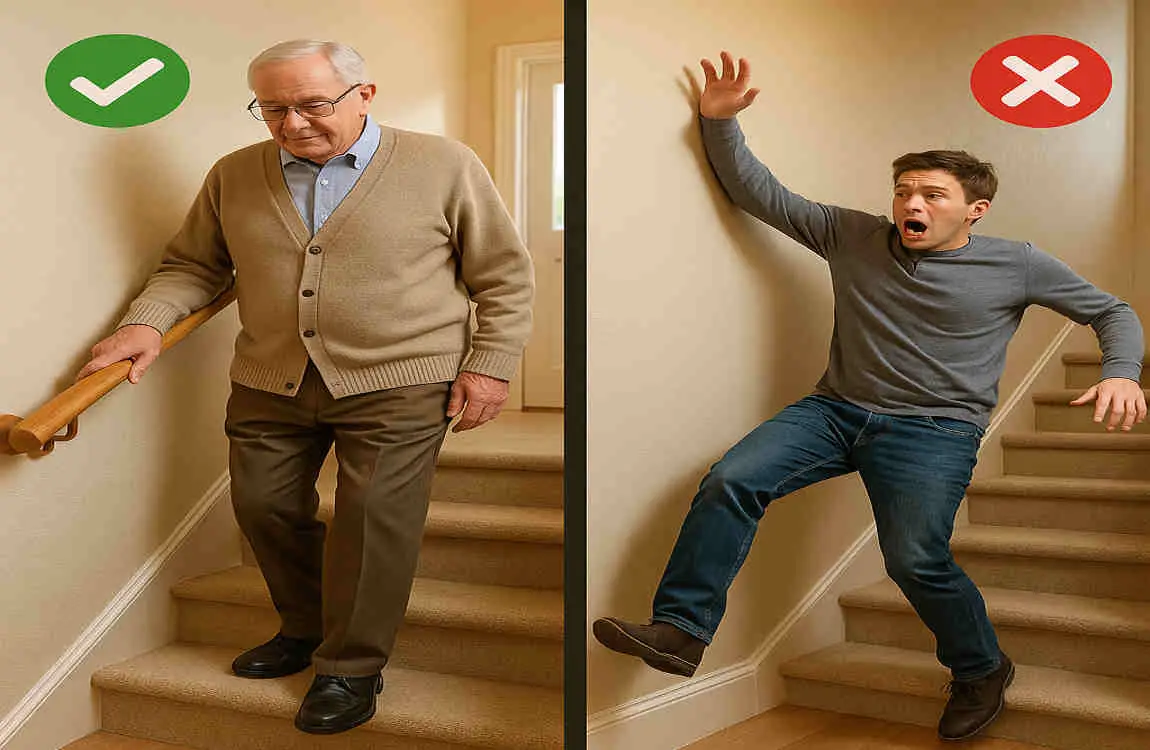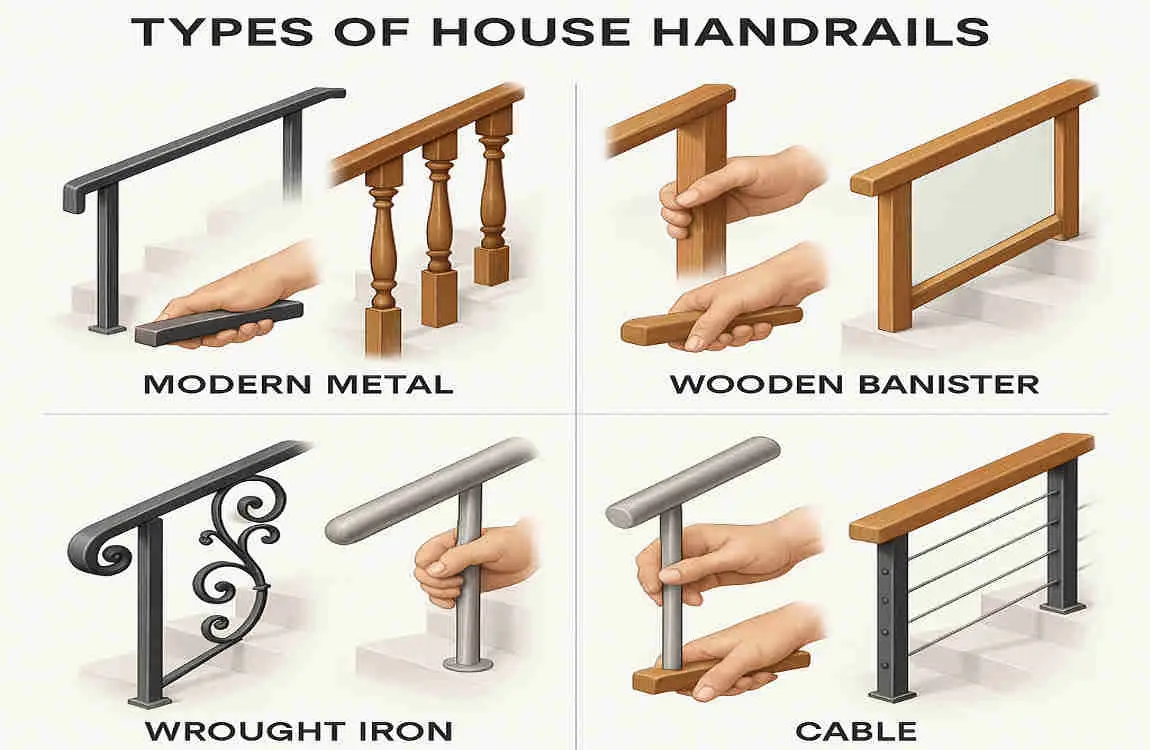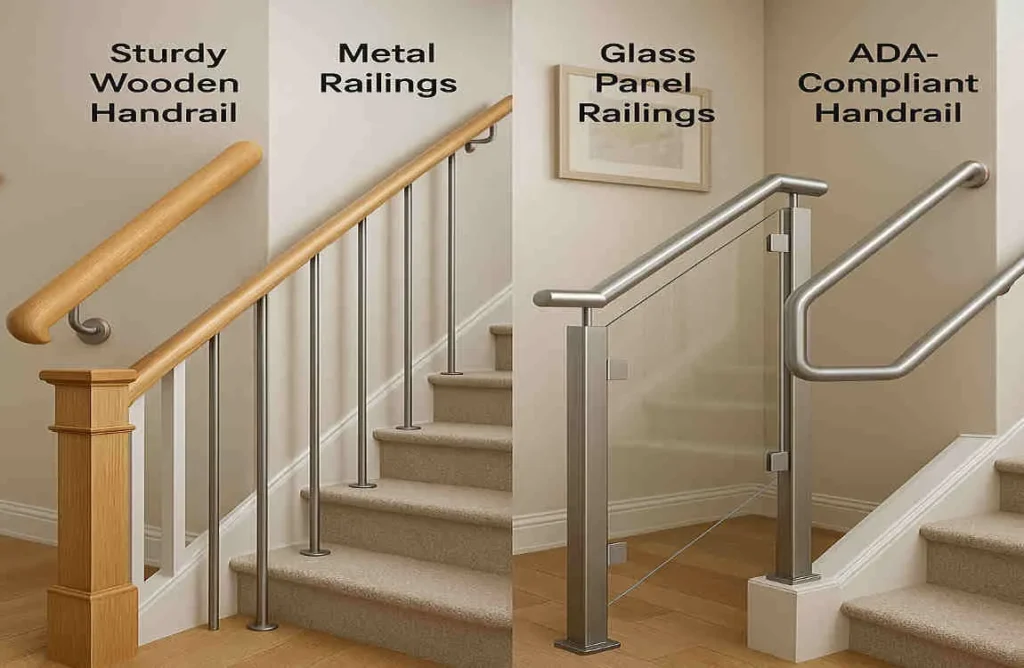When it comes to keeping your home safe and stylish, choosing the right type of house handrail is crucial. Handrails aren’t just there to add a touch of elegance to your staircase or balcony; they play a vital role in preventing accidents and ensuring the safety of everyone in your household.
Why Are House Handrails Important for Safety?

Have you ever thought about how a simple handrail can make a big difference in your daily life? House handrails are more than just decorative elements; they are essential safety features that can prevent falls and accidents.
The Role of Handrails in Preventing Falls and Accidents
Imagine you’re carrying a heavy load up the stairs, or you’re feeling a bit unsteady on your feet. A sturdy handrail can be your lifeline, providing the support and balance you need to navigate your home safely. Handrails act as a guide, helping you maintain your footing and reducing the risk of slips and falls.
Key Safety Benefits
Handrails offer three key safety benefits:
- Support: They provide a stable surface to hold onto, reducing the strain on your legs and back as you climb stairs or navigate uneven surfaces.
- Balance: By gripping a handrail, you can maintain your balance, even if you stumble or lose your footing momentarily.
- Guidance: Handrails act as a visual and tactile guide, helping you navigate your home, especially in low-light conditions.
Relevant Safety Standards and Building Codes
To ensure the safety of your household, it’s essential to adhere to relevant safety standards and building codes when installing handrails. These regulations vary by location, but they generally cover aspects such as handrail height, spacing, and grip size. Consulting with a professional installer can help you navigate these requirements and ensure your handrails meet the necessary standards.
Who Benefits Most?
While handrails are beneficial for everyone, certain groups may find them particularly helpful:
- Elderly: As we age, our balance and mobility can decline, making handrails a crucial safety feature for older adults.
- Children: Young children are prone to accidents and may benefit from the added support and guidance provided by handrails.
- People with Mobility Issues: Individuals with disabilities or mobility challenges can significantly benefit from the added stability and support offered by well-designed handrails.
Key Factors to Consider When Choosing House Handrails
Now that we understand the importance of handrails, let’s explore the key factors to consider when choosing the best type of house handrail for your needs.
You may also read (transform you living room with house stylish wall lights).
Grip and Ergonomics
The shape and profile of your handrail can significantly impact its safety and usability. A handrail with a comfortable grip and ergonomic design will be more straightforward to hold onto, reducing the risk of slips and falls. Consider factors such as the diameter of the handrail, the texture of the surface, and the angle of the grip when making your selection.
Height and Length Standards
To ensure maximum safety, handrails should be installed at the appropriate height and length. The ideal height for a handrail is typically between 34 and 38 inches from the surface of the stairs or floor. The length of the handrail should extend the full length of the stairs or the area it is intended to protect.
Material Durability and Maintenance
The material you choose for your handrail will impact its durability and maintenance requirements. Some materials, such as metal or glass, may be more durable and resistant to wear and tear, while others, like wood, may require more frequent maintenance to keep them in good condition. Consider your lifestyle and the level of maintenance you’re willing to commit to when selecting a material.
Indoor vs. Outdoor Suitability
Not all handrails are created equal when it comes to indoor and outdoor use. Some materials, such as certain types of wood or metal, may not withstand the elements as well as others. If you’re installing a handrail for an outdoor space, like a deck or balcony, be sure to choose a material that can withstand the local weather conditions.
Style and Compatibility with Home Décor
While safety should always be the top priority when choosing a handrail, you don’t have to sacrifice Style for function. Handrails come in a wide range of designs and finishes, allowing you to select one that complements your home’s décor. Whether you prefer a sleek, modern look or a more traditional Style, there’s a handrail out there that will meet your safety needs and enhance your home’s aesthetic.
Types of House Handrails by Material
Now that we’ve covered the key factors to consider when choosing a handrail, let’s explore the different types of house handrails based on their materials.
Metal Handrails
Metal handrails are a popular choice for many homeowners due to their strength, durability, and sleek appearance. Common metals used for handrails include stainless steel, aluminum, and wrought iron.
Safety Benefits
Metal handrails offer several safety benefits:
- Strength: Metal handrails are incredibly strong and can withstand heavy use and impact.
- Durability: They are resistant to wear and tear, making them a long-lasting option for your home.
- Slip Resistance: Many metal handrails have textured surfaces or coatings that provide added grip and reduce the risk of slips.
Pros and Cons
Like any material, metal handrails have their pros and cons:
- Pros:
- Rust-resistant options available
- Low maintenance
- Sleek, modern appearance
- Cons:
- Can be cold to the touch
- May require professional installation
- Can be more expensive than other materials
Suitable Applications
Metal handrails are suitable for a variety of applications, including:
- Indoor staircases
- Outdoor decks and balconies
- Commercial settings
Wood Handrails
Wood handrails offer a warm, classic look that can complement many home styles. Common types of wood used for handrails include oak, walnut, and maple.
Warmth and Classic Aesthetics
One of the main advantages of wood handrails is their ability to add warmth and character to your home. The natural beauty of wood can enhance your staircase or balcony, creating a welcoming and inviting atmosphere.
Durability and Maintenance Considerations
While wood handrails can be durable, they do require more maintenance than some other materials. Regular cleaning and sealing are necessary to protect the wood from moisture and wear. Additionally, wood handrails may be more prone to scratches and dents than metal or glass options.
Best Uses and Safety Tips
Wood handrails are best suited for indoor applications, such as staircases and hallways. To ensure safety, be sure to:
- Choose a smooth finish to prevent splinters
- Securely mount the handrail to the wall or posts
- Regularly inspect the handrail for signs of wear or damage
Glass Handrails
Glass handrails offer a modern, sleek look that can open up your space and create a sense of airiness. They are typically made from tempered or laminated safety glass.
Modern Aesthetics and Visibility Advantages
One of the main advantages of glass handrails is their ability to maintain an open, airy feel in your home. The transparency of the glass allows for unobstructed views and can make small spaces feel larger.
Safety with Tempered Glass
To ensure safety, glass handrails should always be made from tempered or laminated safety glass. These types of glass are designed to shatter into small, blunt pieces rather than sharp shards, reducing the risk of injury in the event of a breakage.
Suitable Locations
Glass handrails are suitable for a variety of locations, including:
- Indoor and outdoor staircases
- Balconies and decks
- Pool areas
Composite and Synthetic Handrails
Composite and synthetic handrails are made from materials like PVC, vinyl, and fiberglass. They offer a durable, low-maintenance option for your home.
Benefits
Composite and synthetic handrails offer several benefits:
- Weather Resistance: They are highly resistant to moisture, UV rays, and temperature fluctuations, making them ideal for outdoor use.
- Low Maintenance: These handrails require minimal upkeep, with no need for painting or sealing.
- Safety Features: Many composite and synthetic handrails have textured surfaces or built-in grip features for added safety.
Safety Features and Grip Considerations
When choosing a composite or synthetic handrail, be sure to consider the grip and safety features. Look for handrails with textured surfaces or built-in grip strips to ensure a secure hold.
Ideal for Outdoor Railings and Pool Areas
Composite and synthetic handrails are particularly well-suited for outdoor applications, such as deck railings and pool fences. Their weather resistance and low maintenance make them a practical choice for these areas.
Types of House Handrails by Design and Grip

In addition to material, the design and grip of your handrail can also impact its safety and usability. Let’s explore some common types of house handrails based on their design and grip.
Pinch Grip Handrails
You may also read (how does stacking improve in house plumbing systems).
Pinch grip handrails have a narrow profile that allows users to grip the handrail between their fingers.
Description
Pinch grip handrails typically have a smaller diameter than other types of handrails, allowing users to wrap their fingers around the rail for a secure hold.
Ideal for Users Needing a Secure Hold
Pinch grip handrails are ideal for users who need a secure, tight grip on the handrail. This may include individuals with limited hand strength or those who need extra support when navigating stairs or uneven surfaces.
Best Installation Settings
Pinch grip handrails are best suited for indoor applications, such as staircases and hallways. They may not be suitable for outdoor use, as the narrow profile can make them more susceptible to damage from the elements.
Circular (Round) Grip Handrails
Circular grip handrails are the most common type of handrail and feature a rounded profile that is easy to grip.
Most Common Ergonomic Shape
The circular shape of these handrails is designed to fit comfortably in the hand, providing an ergonomic grip that is easy to hold onto.
Ease of Use and Safety Benefits
Circular grip handrails are easy to use and offer several safety benefits:
- Ease of Grip: The rounded shape allows for a comfortable, secure grip.
- Versatility: These handrails can be used by people of all ages and abilities.
- Reduced Risk of Injury: The smooth, rounded edges minimize the risk of injury from sharp corners or edges.
Popular Materials for This Design
Circular grip handrails can be made from a variety of materials, including:
- Metal (stainless steel, aluminum, wrought iron)
- Wood (oak, walnut, maple)
- Composite and synthetic materials (PVC, vinyl, fiberglass)
Wall-Mounted Handrails
Wall-mounted handrails are attached directly to the wall, providing a space-saving and sturdy option for your home.
Space-Saving and Sturdy Option
Wall-mounted handrails are an excellent choice for narrow staircases or hallways where space is at a premium. They provide a sturdy, reliable source of support without taking up valuable floor space.
Safety Considerations for Mounting Height and Hardware
To ensure safety, wall-mounted handrails should be installed at the appropriate height (typically between 34 and 38 inches from the surface of the stairs or floor) and securely fastened to the wall using appropriate hardware. Consult with a professional installer to ensure your handrail meets safety standards and is appropriately secured.
Appropriate Indoor Locations
Wall-mounted handrails are best suited for indoor applications, such as:
- Staircases
- Hallways
- Bathrooms
Post-Mounted Handrails
Post-mounted handrails are freestanding and supported by posts, making them a versatile option for a variety of settings.
Freestanding with Support Posts
Post-mounted handrails are not attached to a wall, but instead, are supported by posts that are anchored to the floor or ground. This design allows for greater flexibility in placement and can be used in a variety of indoor and outdoor settings.
Use on Decks, Porches, and Stairs
Post-mounted handrails are particularly well-suited for outdoor applications, such as:
- Decks and balconies
- Porches and patios
- Outdoor staircases
Safety and Stability Features
To ensure safety and stability, post-mounted handrails should be securely anchored to the ground or floor using appropriate hardware. The posts should be spaced at regular intervals to provide consistent support along the length of the handrail. Regular maintenance and inspections are also essential to ensure the handrail remains stable and secure over time.
Specialized Safety Handrails and Features
In addition to the standard types of house handrails, there are also specialized options designed to meet specific safety needs.
Handrails for Mobility-Impaired Users
Handrails designed for mobility-impaired users are typically ADA (Americans with Disabilities Act) or DDA (Disability Discrimination Act) compliant, meeting specific standards for accessibility and safety.
ADA/DDA Compliant Handrails
ADA and DDA-compliant handrails must meet specific criteria, such as:
- Height: The handrail must be between 34 and 38 inches from the surface of the stairs or floor.
- Grip Size: The handrail must have a diameter between 1.25 and 2 inches to accommodate users with limited hand strength or dexterity.
- Clearance: There must be sufficient clearance between the handrail and the wall to allow for a comfortable grip.
Benefits for Users with Mobility Challenges
Handrails designed for mobility-impaired users can provide numerous benefits, including:
- Increased Independence: These handrails can help users navigate their homes more safely and independently.
- Reduced Risk of Falls: By providing a secure, comfortable grip, these handrails can reduce the risk of slips and falls.
- Improved Accessibility: ADA and DDA-compliant handrails can make your home more accessible to users with mobility challenges, allowing them to move freely and confidently.
Continuous Handrails
Continuous handrails are designed to provide uninterrupted support along the length of a staircase or hallway.
Uninterrupted Support
Unlike some handrails that may have gaps or interruptions, continuous handrails run the entire length of the stairs or hallway, providing consistent support and guidance for users.
Benefits for Users with Limited Mobility
Continuous handrails can be particularly beneficial for users with limited mobility, as they:
- Reduce the Need to Let Go: By providing a constant grip, these handrails reduce the need for users to let go and re-grip the handrail, which can be challenging for those with limited hand strength or dexterity.
- Increase Confidence: The uninterrupted support of a continuous handrail can help users feel more confident and secure as they navigate their home.
Installation Considerations
When installing a continuous handrail, it’s essential to:
- Ensure Proper Height and Spacing: The handrail should be installed at the appropriate height and spaced evenly along the length of the stairs or hallway.
- Use Secure Mounting Hardware: The handrail should be securely fastened to the wall or posts using appropriate hardware to ensure stability and safety.
- Consider Accessibility Needs: If the handrail is intended for use by individuals with mobility challenges, be sure to consult with a professional installer to ensure it meets ADA or DDA compliance standards.
Handrails with Integrated Lighting
Handrails with integrated lighting can provide added safety and visibility in low-light conditions.
Improved Visibility in Low-Light Conditions
Integrated lighting can help illuminate the path ahead, making it easier for users to navigate stairs or hallways in the dark. This can be particularly beneficial for older adults or individuals with limited vision.
Types of Lighting Options
There are several types of lighting options available for handrails, including:
- LED Strips: These can be installed along the length of the handrail, providing a soft, even glow.
- Motion-Activated Lights: These lights turn on automatically when someone approaches the handrail, providing instant illumination.
- Battery-Powered Lights: These lights can be easily installed and require no wiring, making them a convenient option for many homeowners.
Safety and Energy Efficiency Considerations
When choosing handrails with integrated lighting, consider the following safety and energy efficiency factors:
- Brightness: The lighting should be bright enough to provide adequate visibility without being too harsh or blinding.
- Energy Efficiency: Look for lighting options that are energy-efficient, such as LED lights, to minimize your energy consumption and reduce your environmental impact.
- Durability: Choose lighting options that are durable and long-lasting, as they will be exposed to regular use and potential wear and tear.
Anti-Slip Coatings and Surfaces
Anti-slip coatings and surfaces can provide added safety and grip for your handrails.
Increased Safety and Grip
Anti-slip coatings and surfaces can help prevent slips and falls by providing a textured, non-slip surface for users to grip. This can be particularly beneficial in wet or slippery conditions, such as in bathrooms or outdoor areas.
Types of Anti-Slip Options
There are several types of anti-slip options available for handrails, including:
- Textured Coatings: These coatings can be applied to the surface of the handrail, providing a textured, non-slip grip.
- Grip Strips: These strips can be adhered to the handrail, providing a high-friction surface for users to hold onto.
- Non-Slip Tapes: These tapes can be wrapped around the handrail, providing a non-slip surface and added visibility.
Maintenance and Durability Considerations
When choosing anti-slip options for your handrails, consider the following maintenance and durability factors:
- Ease of Cleaning: Choose options that are easy to clean and maintain, as they will be exposed to regular use and potential dirt and grime.
- Durability: Select anti-slip options that are durable and long-lasting, as they will need to withstand frequent use and potential wear and tear.
- Compatibility: Ensure that the anti-slip option you choose is compatible with the material and design of your handrail, as some options may not adhere well to certain surfaces.
How to Properly Install Handrails for Maximum Safety
Proper installation is crucial to ensuring the safety and effectiveness of your handrails. Here are some key tips for installing handrails correctly:
Importance of Professional Installation
While some handrail installations may seem straightforward, it’s always best to consult with a professional installer to ensure your handrails meet safety standards and are appropriately secured. A professional can assess your specific needs and provide guidance on the best type of handrail and installation method for your home.
Correct Height and Spacing Guidelines
To ensure maximum safety, handrails should be installed at the appropriate height and spacing. The ideal height for a handrail is typically between 34 and 38 inches from the surface of the stairs or floor. The handrail should be spaced evenly along the length of the stairs or hallway, with no gaps or interruptions that could pose a safety hazard.
Secure Fixing Methods and Hardware
Handrails should be securely fastened to the wall or posts using appropriate hardware, such as screws, brackets, or anchors. The specific fixing method will depend on the type of handrail and the surface it is being attached to, so be sure to consult with a professional installer for guidance.
Maintenance Tips to Ensure Long-Lasting Safety
To keep your handrails safe and effective over time, regular maintenance is essential. Here are some tips for maintaining your handrails:
- Regular Cleaning: Clean your handrails regularly to remove dirt, grime, and potential hazards.
- Inspections: Periodically inspect your handrails for signs of wear, damage, or loosening, and address any issues promptly.
You may also read (how to choose modern roof paint colors for your home).

